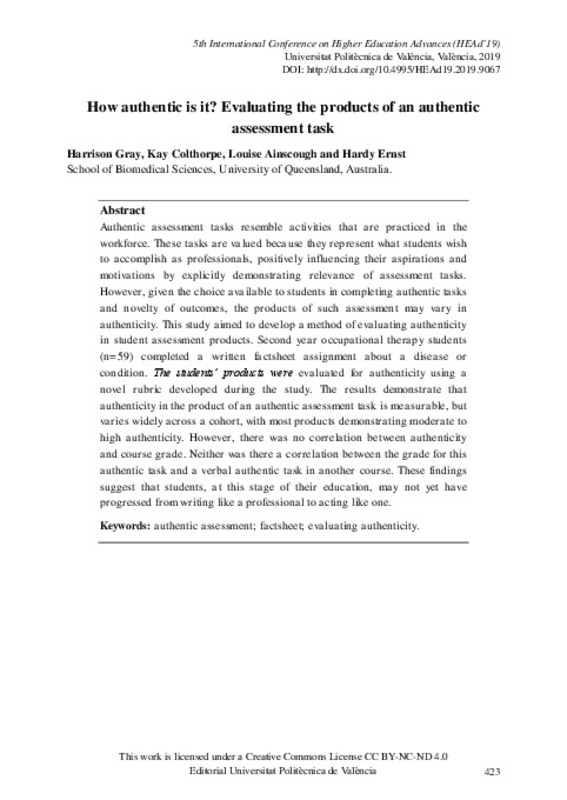JavaScript is disabled for your browser. Some features of this site may not work without it.
Buscar en RiuNet
Listar
Mi cuenta
Estadísticas
Ayuda RiuNet
Admin. UPV
How authentic is it? Evaluating the products of an authentic assessment task
Mostrar el registro sencillo del ítem
Ficheros en el ítem
| dc.contributor.author | Gray, Harrison
|
es_ES |
| dc.contributor.author | Colthorpe, Kay
|
es_ES |
| dc.contributor.author | Ernst, Hardy
|
es_ES |
| dc.contributor.author | Ainscough, Louise
|
es_ES |
| dc.date.accessioned | 2019-07-29T06:24:07Z | |
| dc.date.available | 2019-07-29T06:24:07Z | |
| dc.date.issued | 2019-07-05 | |
| dc.identifier.isbn | 9788490486610 | |
| dc.identifier.issn | 2603-5871 | |
| dc.identifier.uri | http://hdl.handle.net/10251/124334 | |
| dc.description.abstract | [EN] Authentic assessment tasks resemble activities that are practiced in the workforce. These tasks are valued because they represent what students wish to accomplish as professionals, positively influencing their aspirations and motivations by explicitly demonstrating relevance of assessment tasks. However, given the choice available to students in completing authentic tasks and novelty of outcomes, the products of such assessment may vary in authenticity. This study aimed to develop a method of evaluating authenticity in student assessment products. Second year occupational therapy students (n=59) completed a written factsheet assignment about a disease or condition. The students’ products were evaluated for authenticity using a novel rubric developed during the study. The results demonstrate that authenticity in the product of an authentic assessment task is measurable, but varies widely across a cohort, with most products demonstrating moderate to high authenticity. However, there was no correlation between authenticity and course grade. Neither was there a correlation between the grade for this authentic task and a verbal authentic task in another course. These findings suggest that students, at this stage of their education, may not yet have progressed from writing like a professional to acting like one. | es_ES |
| dc.format.extent | 9 | es_ES |
| dc.language | Inglés | es_ES |
| dc.publisher | Editorial Universitat Politècnica de València | es_ES |
| dc.relation.ispartof | HEAD'19. 5th International Conference on Higher Education Advances | es_ES |
| dc.rights | Reconocimiento - No comercial - Sin obra derivada (by-nc-nd) | es_ES |
| dc.subject | Higher Education | es_ES |
| dc.subject | Learning | es_ES |
| dc.subject | Educational systems | es_ES |
| dc.subject | Teaching | es_ES |
| dc.subject | Authentic assessment | es_ES |
| dc.subject | Factsheet | es_ES |
| dc.subject | Evaluating authenticity | es_ES |
| dc.title | How authentic is it? Evaluating the products of an authentic assessment task | es_ES |
| dc.type | Capítulo de libro | es_ES |
| dc.type | Comunicación en congreso | es_ES |
| dc.identifier.doi | 10.4995/HEAD19.2019.9067 | |
| dc.rights.accessRights | Abierto | es_ES |
| dc.description.bibliographicCitation | Gray, H.; Colthorpe, K.; Ernst, H.; Ainscough, L. (2019). How authentic is it? Evaluating the products of an authentic assessment task. En HEAD'19. 5th International Conference on Higher Education Advances. Editorial Universitat Politècnica de València. 423-431. https://doi.org/10.4995/HEAD19.2019.9067 | es_ES |
| dc.description.accrualMethod | OCS | es_ES |
| dc.relation.conferencename | Fifth International Conference on Higher Education Advances | es_ES |
| dc.relation.conferencedate | Junio 26-28, 2019 | es_ES |
| dc.relation.conferenceplace | València, Spain | es_ES |
| dc.relation.publisherversion | http://ocs.editorial.upv.es/index.php/HEAD/HEAD19/paper/view/9067 | es_ES |
| dc.description.upvformatpinicio | 423 | es_ES |
| dc.description.upvformatpfin | 431 | es_ES |
| dc.type.version | info:eu-repo/semantics/publishedVersion | es_ES |
| dc.relation.pasarela | OCS\9067 | es_ES |








